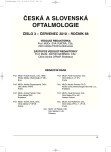-
Medical journals
- Career
Sodium Pegaptanib and Ranibizumab in the Treatment of the Retinal Pigment Layer Ablation in a Patient with Age-Related Macular Degeneration – A Case Report
Authors: M. Šín; J. Šimičák; Z. Prachařová; J. Řehák
Authors‘ workplace: Oční klinika FN a UP, Olomouc, přednosta doc. MUDr. Jiří Řehák, CSc.
Published in: Čes. a slov. Oftal., 66, 2010, No. 3, p. 138-141
Category: Case Report
Overview
The case report presents the difference of the effect of two drugs blocking vascular endothelial growing factor (anti-VEGF) – sodium pegaptanib and ranibizumab – in a female patient with the retinal pigment epithelium (RPE) layer ablation as a part of the exsudative age-related macular degeneration.
Fifty-five years old female patient with RPE ablation as a sign of exsudative ARMD and central visual acuity 79 letters of the EDTRS chart in the left eye was treated by 5 intravitreal injections of sodium pegaptanib. The treatment was not sufficiently effective according to the fluorescein angiography (FAG) and optic coherence tomography (OCT) findings and was accompanied by further decrease of the visual acuity to 55 letters of the EDTRS chart. After the medication was switched to ranibizumab with 3 intravitreal applications, the RPE ablation flattened according to the OCT findings and the fluorescein leakage during the FAG markedly decreased. The central visual acuity improved to 63 letters of the EDTRS chart. The decreased activity of the choroidal neovascularization (CNV) is observed during the following 4 months after the last intravitreal application of ranibizumab.
Ranibizumab seems to be more effective drug comparing to the sodium pegaptanib in patients with the RPE ablation, but it is necessary to consider the increased probability of the RPE rupture risk.Key words:
age-related macular degeneration, retinal pigment epithelium ablation, ranibizumab, sodium pegaptanib
Sources
1. Ahuja RM., Stannga PE.,Vingerling JR. et al.: Polypoidal choroidal vasculophaty in exsudative and hemorrhagic pigment epithelial detachment. Br. J. Ophthalmology, 8, 2000 : 479–484.
2. Gragouhas E.S., AdamiA.P., Cunningham E.T. et al.: VEGF inhibition study in ocular neovascularisation clinical trial group. Pegaptanib for neovascular age-related macular degeneration. N Engl. J. Med., 351, 2004 : 2805–2816.
3. Chang LK., Sarraf D.: Tears of the RPE: an old problem in a new era. Retina, 27, 2007 : 23–527.
4. Chrapek O., Jirkova B., Šín M. et al.: Současné možnosti léčby vlhké formy věkem podmíněné makulární degenerace. Čes. a Slov. Oftal., 6, 2008 : 249–251.
5. Ischida S.,Usui T., Yamasiro K. et al.: VEGF 164-mediated inflammation is required for patological but not physiological, ischemia-induce retinal neovascularisation. J. Exp. Med., 19, 2003 : 483–489.
6. Kletner A., Roider J.: Comparation of Bevacizumab, Ranibizumab and Pegaptanib in vitro: efficiency and possible additional pathways. Incest. Ophthalmol. Vis. Sci.,49, 2008 : 4523–4527.
7. Lommatzsch A, Heimes B, Gutfleisch M. et al.: Serous pigment epithelial detachment in age-related macular degeneration: comparison of different treatments. , 23, 2009,12 : 2163–2168.
8. Lommatzsch AP, Heimes B, Gutfleisch M. et al.: Treatment of vascularised serous pigment epithelium detachment in AMD – observations after changing the intravitreal agent due to lack of response. Klin. Monatsbl. Augenheilkd., 225, 2008, 10 : 874–879.
9. Manish N., Kamal N., Nagpal MS.: A comparative debate on the various anti-vascular endothelial growth factor drugs: Pegaptanib sodium (Macugen), ranibizumab (Lucentis) and bevacizumab (Avastin). Ind. J. Oph., 55, 2007, 6 : 437–439.
10. Pauleikhoff D., Loffert D.,Spital G. et al.: Pigment epithelial detachment in the elderly – clinical differentiation, natural course and pathogenetic implications. Graef. Arch. Clin. Exp Ophthal., 240, 2004 : 533–538.
11. Studnička J.: Ranibizumab (Lucentis) v léčbě věkem podmíněné makulární degenerace. Čes. a slov. Oftal., 3, 2009 : 107–111.
Labels
Ophthalmology
Article was published inCzech and Slovak Ophthalmology

2010 Issue 3-
All articles in this issue
- Czech Ophthalmologic Society’s Data Collecting System for the Monitoring and Evaluating of the Exsudative Age-Related Macular Degeneration Treatment – the Nation-Wide Project “AMADEUS”
- Exsudative Age-Related Macular Degeneration Treatment Results in Patients Registered in the Nation-Wide AMADEUS Register
- Combined Therapy in the Exsudative Age-Related Macular Degeneration (Photodynamic Therapy and Intravitreally-Applied Ranibizumab)
- Epidemiology of the Age-Related Macular Degeneration
- Treatment of the Choroidal Neovascular Membrane by Ranibizumab (Lucentis): A Case Report
- Sodium Pegaptanib and Ranibizumab in the Treatment of the Retinal Pigment Layer Ablation in a Patient with Age-Related Macular Degeneration – A Case Report
- The Change of the anti-VEGF Agent in the Treatment of Exceptionally Active Choroidal Neovascular Membrane in Age-Related Macular Degeneration
- Photodynamic Therapy with Verteporfin: from Neovascularization to Hemangioma
- Czech and Slovak Ophthalmology
- Journal archive
- Current issue
- Online only
- About the journal
Most read in this issue- Treatment of the Choroidal Neovascular Membrane by Ranibizumab (Lucentis): A Case Report
- Epidemiology of the Age-Related Macular Degeneration
- The Change of the anti-VEGF Agent in the Treatment of Exceptionally Active Choroidal Neovascular Membrane in Age-Related Macular Degeneration
- Photodynamic Therapy with Verteporfin: from Neovascularization to Hemangioma
Login#ADS_BOTTOM_SCRIPTS#Forgotten passwordEnter the email address that you registered with. We will send you instructions on how to set a new password.
- Career

